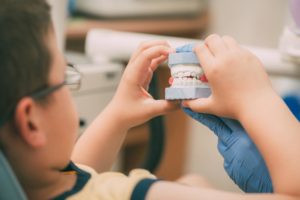So, You’ve Got a Broken Tooth. Now What?
 Summer is full of fun activities like playing sports or taking a family vacation. And yet, all that fun can often come with a lot of mishaps and accidents. Remember last year’s family baseball league when little Susie tried her hand at batting and to everyone’s (mostly your) surprise her fly ball left you with a broken tooth?
Summer is full of fun activities like playing sports or taking a family vacation. And yet, all that fun can often come with a lot of mishaps and accidents. Remember last year’s family baseball league when little Susie tried her hand at batting and to everyone’s (mostly your) surprise her fly ball left you with a broken tooth?
A broken front tooth impairs your ability to eat and talk, and it can just be embarrassing. Immediately after breaking or losing a tooth, you need to act fast. Here are some tips to help you restore your smile quickly:
Know the status of your broken tooth
A broken tooth is a broken tooth, right? There are actually several varieties of broken teeth, and each has its own symptoms and treatment plan.
Loose tooth
As a result of taking a hit to the mouth, your tooth can suffer a concussion. That’s really just a fancy name for a loose tooth, and it’s typically accompanied by some bleeding and moderate pain.
You may feel a bit relieved and willing to wait a bit longer before seeking treatment since your tooth hasn’t fallen out completely, but sometimes the worse part of a loose tooth isn’t visible to you. If your tooth is still intact but a little loose, the tooth might have damage to the root or have been pushed into your jaw. It’s for this reason that it is imperative you seek emergency dental treatment as soon as possible after the trauma occurs.
Broken tooth
A broken tooth simply means that a large part of the tooth has been knocked out. If you have a broken tooth, you’re probably suffering from moderate to severe pain. With a broken tooth, it’s important to see a dentist as soon as possible because if left untreated, a broken tooth can result in infection, swelling, and an otherwise avoidable medical emergency.
Tooth avulsion
A tooth that has been knocked clean out, also called a tooth avulsion, will bleed the most out of these three traumas. You need to apply pressure to the wound to stop the bleeding, and head for the emergency room if the bleeding doesn’t stop within 30 minutes or if you have a history of problems with clotting after an injury. If it’s possible, find the tooth, place it in milk, or water or yes, even saliva, if milk isn’t available, to preserve it while you make an emergency dentist appointment.
What to expect at the dentist
Each scenario is different, but most likely, you will have X-rays taken of the affected area to determine the severity of the trauma and to help create a suitable treatment plan. If the original tooth can be saved, it’s common to try and save it. The broken front tooth may be splinted to the teeth on either side of it to help keep it stable while it heals. Other options can include reinserting an avulsed tooth. If the tooth can be reinserted, which is the best case scenario, expect some follow-up appointments so we can monitor the healing of your tooth.
If none of these options are possible because the broken front tooth cannot be saved, it’s important to openly discuss your options for short or long-term tooth replacement options. A crown, bridge, implant, or partial denture are all possible options.
The most important thing to keep in mind if you have a broken tooth is to act fast. Your tooth isn’t going to heal itself, so get to the dentist as soon as possible after the trauma occurs. Not seeking medical care immediately can lead to an infection or create a more severe trauma than what had originally occurred.
At Willow Spring Family Dentistry, we’ve got you covered! We know a thing or two about cosmetic dentistry and oral surgeries, and we strive to provide the best care so you can rest easy.

